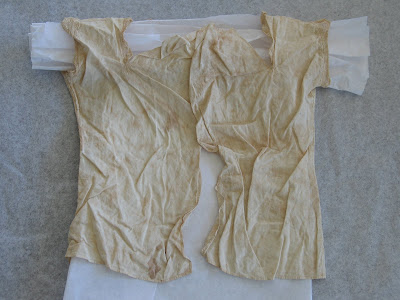Children's Clothing in the Victorian Era

Hallo my darling smunchkims. Today I want to take you back to the "Victorian era, when young children were seen and not heard, and to show you another wonderful piece of children's clothing from the Lynda Braid Collection. The image you see above is the cover of a Victorian magazine from 1884, called The Family Friend.

At this time ready made clothing was not as readily available as it is today, and Mother's were expected to sew their children's clothes, if they were not wealthy enough to employ servants to sew for them. The family Friend Magazine offered free patterns for children's clothes for home sewers to use, and here is a pattern for a child's pinafore.

Half a yard of diaper, this must have been the fabric used for early nappies, and the reason for their American name.

The insertion, is the lace.

The 1880's was the time of the Aesthetic Movement, a movement that encouraged healthy comfortable clothing.

Here is another piece of children's clothing from my cousin Lynda's collection. At first glance it seems to be of little interest, it is in poor condition with extensive discolouration and heavily creased from storage.

It is difficult to make out the shape as it is so creased.

It is when you look closely at this little piece that it starts to shine, look at the handwork on the shoulder seam, and the lace around the armhole. This garment was made in an age when women were highly skilled needle workers, the lace is hand made, and the pinafore is completely sewn by hand.

The technique used on the shoulder seam is wonderful don't you think? I have never seen a seam sewn like this before. If you are a wonderfully clever darling, and know more about this technique, its name, or when it was popular, please let me know. I am not sure what era this little garment is from, it seems early 1800's maybe even 1700's to me, but I am woefully inadequate and lacking in expertise, so if you can add from a deeper fountain of knowledge, please let me know.
































 The name Lolita came from a film of the same name made in 1962 film by Stanley Kubrick based on the classic novel of the same name by Vladimir Nabokov. Sue Lyon played Lolita in the film, she was 14 years old at the time. The story follows the infatuation of an older man, for the young Lolita, and his eventual kidnapping of her, so that he could have his wicked way with her. The Lolita look is the full blown manifestation of youth culture really, a kind of sexualisation of childhood, that is seen in the Japanese subculture of the same name.
The name Lolita came from a film of the same name made in 1962 film by Stanley Kubrick based on the classic novel of the same name by Vladimir Nabokov. Sue Lyon played Lolita in the film, she was 14 years old at the time. The story follows the infatuation of an older man, for the young Lolita, and his eventual kidnapping of her, so that he could have his wicked way with her. The Lolita look is the full blown manifestation of youth culture really, a kind of sexualisation of childhood, that is seen in the Japanese subculture of the same name.





